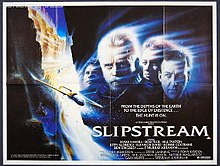Slipstream (1989 film)
| Slipstream | |
|---|---|

UK Theatrical release cinema poster
|
|
| Directed by | Steven Lisberger |
| Produced by | Gary Kurtz |
| Screenplay by | Tony Kayden |
| Story by |
|
| Starring | |
| Music by | Elmer Bernstein |
| Cinematography | Frank Tidy |
| Edited by | Terry Rawlings |
|
Production
company |
Entertainment Film
|
|
Release date
|
|
|
Running time
|
102 minutes |
| Country | United Kingdom |
| Language | English |
Slipstream is a 1989 science fiction film directed by Steven Lisberger, who had previously directed the cult classic 1982 science fiction film Tron. It was produced by Gary Kurtz, best known for his collaboration with George Lucas on the first two Star Wars films and American Graffiti. Slipstream reunited Kurtz with his Star Wars lead Mark Hamill, who features alongside Bill Paxton, Bob Peck and Kitty Aldridge, with cameo appearances from Robbie Coltrane, Ben Kingsley and F. Murray Abraham.
Slipstream is set in a dystopian future, following a global environmental disaster. A voice over at the beginning of the film explains that a doomsday event, the "Convergence, has destroyed the balance of the world's weather systems, with the result that the jet stream has expanded to the planet's surface, with the surface scoured by winds far surpassing anything ever seen before, destroying cities and entire nations. Many bizarre communities have survived in the valleys and caves, some regressing to primitive states, others embracing advanced technologies. Many are isolationist and some are attacked by marauding bandits. Ground transport is no longer possible due to the atmospheric conditions, but skilled pilots can travel by air, following the fierce winds and travelling with their flow, a practice known as "riding the slipstream". The remnants of society have therefore become airborne; most now reside on high precipices or in caves beneath the howling Slipstream. It is also stated that nobody has ever been to the ends of the Slipstream, because atmospheric conditions there make human survival impossible.
...
Wikipedia
